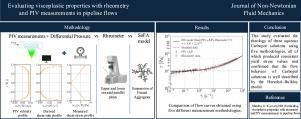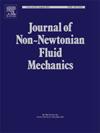Evaluating viscoplastic properties with rheometry and PIV measurements in pipeline flows
IF 2.8
2区 工程技术
Q2 MECHANICS
引用次数: 0
Abstract
Non-Newtonian fluids, widely utilized in industries such as cosmetics, food processing, and petroleum, exhibit shear-dependent viscosity, necessitating precise rheological characterization for effective pipeline and equipment design. In the petroleum industry, for instance, oils can transition from Newtonian to non-Newtonian behavior under specific conditions, such as long-distance horizontal flow at high pressures and low temperatures (near crystallization). In these cases, oils often behave as viscoplastic fluids, requiring a minimum shear stress, known as yield stress, to initiate flow. The Herschel–Bulkley model is a well-established equation for describing the viscous behavior of such fluids through three rheological parameters: yield stress, power-law index, and consistency coefficient. The determination of these parameters is essential for computing flow characteristics, friction factors, and pressure drops—crucial for designing efficient transport systems. This study aims to characterize a viscoplastic fluid by determining its rheological properties from rheometric and in-situ measurements. To accomplish this, an experimental setup was developed using a model fluid prepared from an aqueous Carbopol and triethanolamine (neutralizing agent) solution. In addition to traditional rheometry, an in-situ approach was evaluated, integrating Particle Image Velocimetry (PIV) with differential pressure sensor data. The velocity profiles obtained enabled the reconstruction of shear rate profiles, while pressure drop data facilitated shear stress profile determination, allowing a flow curve reconstruction. Furthermore, the modified SoFA model (Suspension of Fractal Aggregates) was applied, utilizing Carbopol and Triethanolamine concentrations to estimate the rheological parameters and obtain the corresponding flow curve. A comparative analysis was conducted between serrated parallel-plate rheometry and the PIV–pressure drop method in a commercial 2 inch (0.053 m) pipeline under laminar flow of the aqueous Carbopol solution. The results confirmed that the Herschel–Bulkley model effectively fit the flow curves across all methodologies, with yield stress values deviating by less than 15%. However, consistency indices () obtained from PIV data were overestimated, likely due to the limited shear rate range at the low mean velocities tested. This study highlights the importance of integrating traditional rheometry with in-situ techniques for a comprehensive rheological characterization.

用流变学和PIV测量方法评价管道流动中的粘塑性特性
非牛顿流体广泛应用于化妆品、食品加工和石油等行业,具有剪切依赖粘度,因此需要精确的流变特性来进行有效的管道和设备设计。例如,在石油工业中,油在特定条件下可以从牛顿态转变为非牛顿态,例如在高压低温(接近结晶)下的长距离水平流动。在这些情况下,油通常表现为粘塑性流体,需要最小的剪切应力(即屈服应力)来启动流动。Herschel-Bulkley模型是一个成熟的方程,它通过三个流变参数来描述这种流体的粘性行为:屈服应力、幂律指数和一致性系数。这些参数的确定对于计算流动特性、摩擦系数和压降至关重要,对于设计高效的输送系统至关重要。本研究旨在通过流变学和原位测量来确定粘塑性流体的流变特性。为了实现这一目标,开发了一个实验装置,使用由卡波波尔和三乙醇胺(中和剂)水溶液制备的模型流体。除了传统的流变法外,还评估了一种原位方法,将颗粒图像测速(PIV)与差压传感器数据相结合。获得的速度剖面可以重建剪切速率剖面,而压降数据有助于确定剪切应力剖面,从而可以重建流动曲线。采用改进的SoFA (Suspension of Fractal Aggregates)模型,利用卡波醇和三乙醇胺的浓度对其流变参数进行估计,得到相应的流动曲线。在Carbopol水溶液层流条件下,对2英寸(0.053 m)商用管道中锯齿平行板流变法与piv压降法进行了对比分析。结果证实,Herschel-Bulkley模型有效地拟合了所有方法的流动曲线,屈服应力值偏差小于15%。然而,从PIV数据中获得的一致性指数(K)被高估了,这可能是由于在低平均测试速度下剪切速率范围有限。这项研究强调了将传统流变学与原位技术结合起来进行全面流变学表征的重要性。
本文章由计算机程序翻译,如有差异,请以英文原文为准。
求助全文
约1分钟内获得全文
求助全文
来源期刊
CiteScore
5.00
自引率
19.40%
发文量
109
审稿时长
61 days
期刊介绍:
The Journal of Non-Newtonian Fluid Mechanics publishes research on flowing soft matter systems. Submissions in all areas of flowing complex fluids are welcomed, including polymer melts and solutions, suspensions, colloids, surfactant solutions, biological fluids, gels, liquid crystals and granular materials. Flow problems relevant to microfluidics, lab-on-a-chip, nanofluidics, biological flows, geophysical flows, industrial processes and other applications are of interest.
Subjects considered suitable for the journal include the following (not necessarily in order of importance):
Theoretical, computational and experimental studies of naturally or technologically relevant flow problems where the non-Newtonian nature of the fluid is important in determining the character of the flow. We seek in particular studies that lend mechanistic insight into flow behavior in complex fluids or highlight flow phenomena unique to complex fluids. Examples include
Instabilities, unsteady and turbulent or chaotic flow characteristics in non-Newtonian fluids,
Multiphase flows involving complex fluids,
Problems involving transport phenomena such as heat and mass transfer and mixing, to the extent that the non-Newtonian flow behavior is central to the transport phenomena,
Novel flow situations that suggest the need for further theoretical study,
Practical situations of flow that are in need of systematic theoretical and experimental research. Such issues and developments commonly arise, for example, in the polymer processing, petroleum, pharmaceutical, biomedical and consumer product industries.

 求助内容:
求助内容: 应助结果提醒方式:
应助结果提醒方式:


